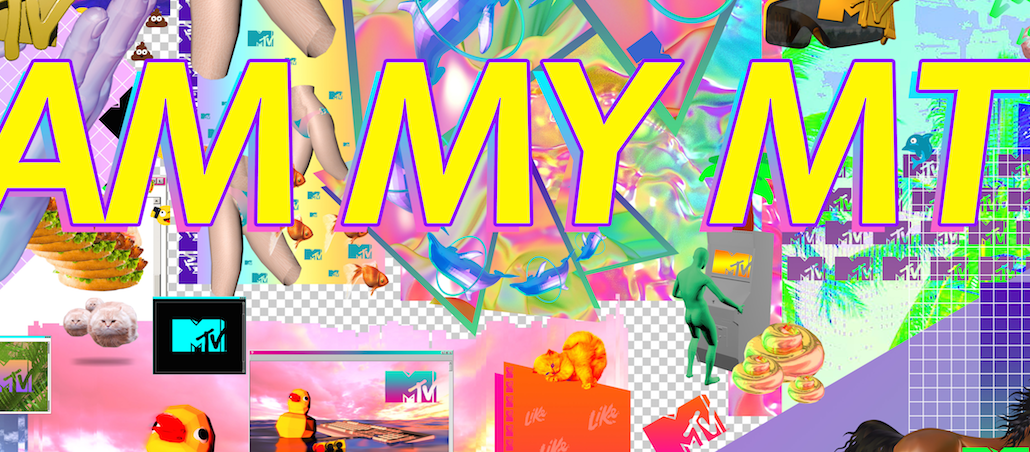MTV International’s ‘massive rebranding’ includes user-generated on-air platform

MTV ceased being “music television” so long ago, it’s become a cliché to point out the irony baked into the network’s name. Musically minded shows like “Headbangers Ball,” “Yo! MTV Raps” and “TRL” were nixed years ago in favor of teen moms and the cast of “Jersey Shore.”
But it’s not just the unstoppable modern reality TV phenomenon that’s changed the network. MTV’s long-loyal demographic of teens and twenty-somethings are spending more and more time on their phones and computers.
Now, for MTV International, a “massive rebranding” is in the works.
According to the network, the rebrand is a way to reconnect to audiences, and MTV Bump will be the first on-air representation of that. The program, launching today, will take content created on social platforms and run it on the air. Made in partnership with New York agency B-Reel Creative, MTV Bump will stream Vines and Instagram videos submitted to the network when its regular programming bumps to a commercial breaks.
“It became clear that our audience is communicating in a different way — across platforms and on devices. That shift has happened,” said Tanya Leedekerken, MTV International’s vp of marketing. “We wanted to see how we could get the brand back to these young people, and you’ll find audience participation and technology play a major role.”
And so — Gen Xers, brace yourselves — MTV’s mantra “I want my MTV” is out. “I am my MTV” is the new network tag.
“The ‘I want my MTV’ generation had to fight to have a voice. It was like a battle cry,” said Ben Hughes, managing creative director at B-Reel Creative. “Young people today have so many ways to get their voices out there with social media. MTV Bump can bring them onto the network, so they’re no longer a passive audience.”

Launching today in the UK, France, Sweden, Brazil, Germany and Australia, MTV Bump will pull clips of content submitted by viewers on MTVBump.com via Instagram and Vine. (Eventually, content will be automatically scraped from the hashtag #MTVBump.) The content will be filtered for local relevance in each market, and can be turned around and put on air within two hours. Users will be notified when their content is going to air, hopefully drawing important young-viewer eyeballs to MTV.
Don’t expect MTV Bump to hit the U.S. just yet, though: The network is testing it out abroad before implementing the program domestically.
MTV isn’t the only youth-oriented network that broadcasts Internet content, however. TheQYou, an international network, airs short-form video “curated by active members of the Internet video creator community” in categories like music, sports, comedy and action. It launched in October with the goal of targeting 25- to 34-year-olds. Scott Ehrlich, the network’s CEO and co-founder, said that for MTV, business has shifted.
“I don’t think it took too great a deal of rocket science to figure out they had to do something new,” said Ehrlich. “There’s been enough shift in the marketplaces to make it clear they had to change strategy.”
Ehrlich added that, especially considering the young demographic MTV Bump targets, it’s impossible to predict whether the platform is something people will use, at least more than once. “But what this does is build a direct connection to the consumer, and that’s a good idea.”
Apart from basic cable TV restrictions (no nudity, illegal activity, brand names or copyrighted music), anything can be submitted to MTV Bump. MTV International will air musical clips, video shorts, visual art and more content from users. In the announcement for MTV Bump, the network calls for videos of “party tricks, cat videos, your breakfast, parkour, playing the trombone — whatever you’re feeling.” But according to Leedekerken, there’s a (now unexpected) focus.
“Music is at the heart of who we are and this will give us more opportunity to spotlight musicians and connect them with fans,” said Leedekerken. “But we also just want to see what happens and let people organically discover it.”
Leedekerken said that MTV International recruited social media stars like Grumpy Cat to launch the first MTV Bump content, claiming that “Everybody’s doing it” in the announcement. Since users’ social handles will be shown with the video, the lure of more followers comes with participation.

Going forward, events like music festivals and holidays (“We’ll suggest people ask their crush out on Valentine’s Day,” said Leedekerken) can be used as prompts for submissions on the platform-campaign hybrid.
“It’s one of those projects that blurs the line between product and marketing,” said Hughes. “One of the main goals [of MTV Bump] is to affect the fabric of the network and become part of the brand. It brings MTV and its audience close together in a really interesting way.”
Leedekerken said that connection is the point of the rebranding.
“‘I am my MTV’ represents a cultural shift,” said Leedekerken. “We’re not afraid to reinvent ourselves, we’re taking risks, and that will be reflected in our program.”
More in Media

YouTube is under fire again, this time over child protection
Adalytics Research asks, ‘Are YouTube advertisers inadvertently harvesting data from millions of children?’

Media Briefing: Publishers pump up per-subscriber revenue amid ad revenue declines
Publishers’ Q2 earnings reveal digital advertising is still in a tight spot, but digital subscriptions are picking up steam.

Lessons for AI from the ad-tech era: ‘We’re living in a memory-less world’
Experts reflect how the failures of social media and online advertising can help the industry improve the next era of innovation.
Ad position: web_bfu